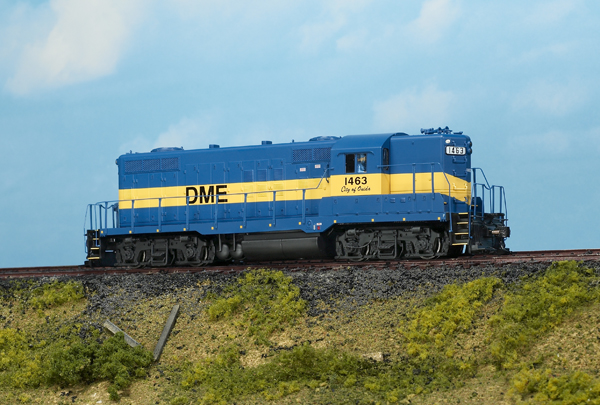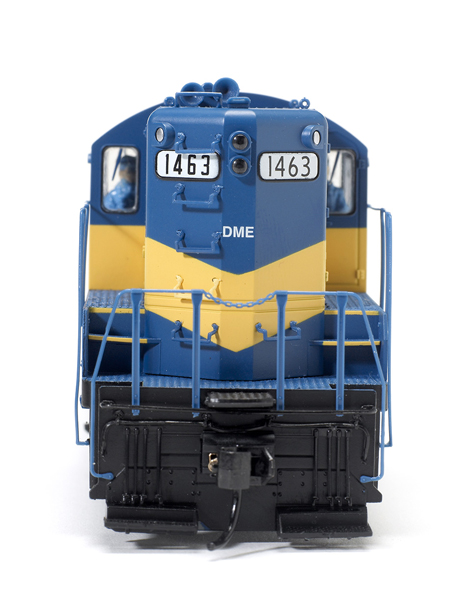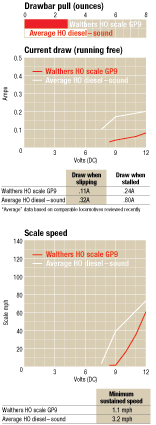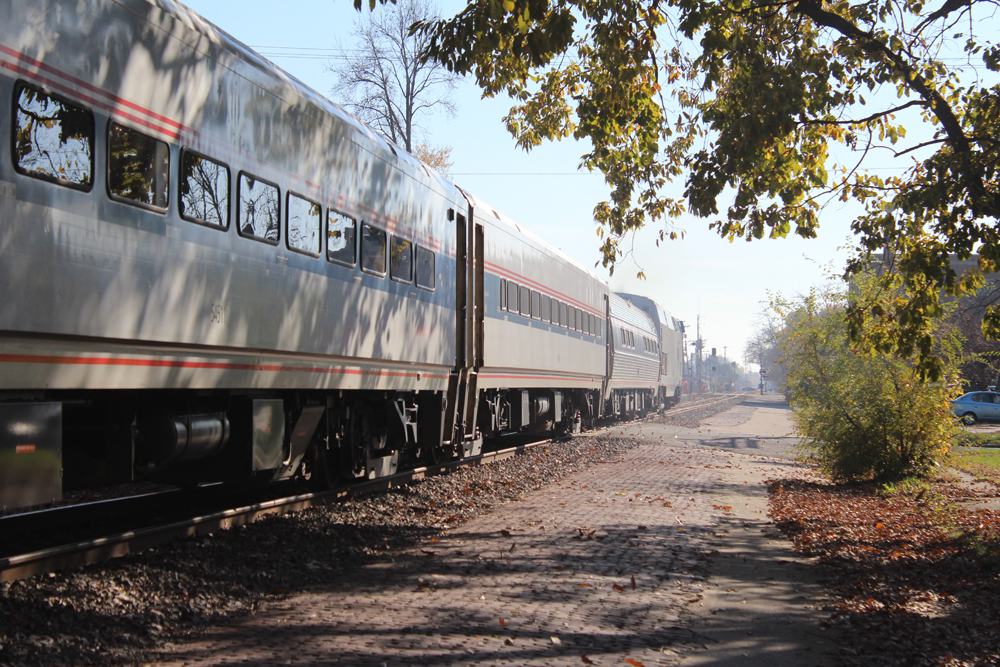Electro-Motive Division built more than 3,600 GP9s from January 1954 until December 1959. Surprisingly, a fair number of these first-generation Geeps are still in operation today on short line and regional railroads. Walthers noticed this trend, and is offering its latest run of four-axle road switchers decorated for granger railroads. [Granger railroads make most of their revenue moving agricultural products. – Ed.] Our sample, a Phase III GP9, is lettered for regional carrier Dakota, Minnesota & Eastern, headquartered in Sioux Falls, S.D.
The model has smoothly applied paint with crisp printing. The Industrial Safety Yellow stripe is opaque, and the separation line between the Ford Blue and yellow is sharp. One standout feature is the fireman’s-side number board on the short nose. This board has EMD-style numbers instead of Alco-style numbers used on the other boards, just like the prototype.
The model, which has more than 60 factory-applied detail parts, also includes a package of modeler-installed items, such as all-weather windows, a winterization hatch, cab sunshades, m.u. receptacles, and wind deflectors.
Though the model features railroad-specific details, some items were omitted, most notably the bell on the short nose and the toolbox behind the cab on the fireman’s side. The DM&E GP9s didn’t have footboards on the pilot, and the vertical handrails by the steps should be yellow.
The GP truck sideframes are crisply molded acetal plastic castings that feature separate brake cylinders and swing hangers. The dual-clasp brakes are appropriate for early Geeps. The 40″ RP-25 contour blackened-metal wheelsets are correctly gauged.
Underneath the shell is a five-pole skew-wound motor with a brass flywheel. A zinc alloy weight, milled to fit around the flywheel, is in the front half of the chassis. Behind the motor is an A-frame mount for two speakers. The printed-circuit board is attached to the weight and speaker frame with four Phillips screws.
The model’s QSI Quantum sound system has sound effects appropriate for the GP9. A 32-page instruction booklet describes how to activate the effects in digital and analog modes. I used the instructions on page 24 to change the locomotive’s address from the factory default, 3, to its road number, 1463. I programmed the locomotive using Model Rectifier’s Prodigy Advance system.
Once I’d programmed the locomotive’s long address, I took the GP9 down to our Milwaukee, Racine & Troy club layout to try consisting it with another engine. Using CVP Products’ Easy DCC system, I set up a two-unit consist. Without hesitation, the two locomotives began moving.
Like other sound-equipped models, the GP9’s starting voltage is high. On direct current the sound effects and lights came on at 4.2 volts, and the unit started moving a scale 1.1 mph at 8.4 volts. With a drawbar pull of 2.88 ounces, the GP9 is capable of pulling 40 average freight cars on straight, level track.
Overall, I was impressed with the Proto 2000 GP9. The unit runs and sounds great. A couple of these locomotives on the point of a grain train rolling across a prairie scene would look cool.
Price: With Digital Command Control and QSI Quantum sound system, $224.98; direct-current model $124.98
Manufacturer
Wm. K. Walthers Inc.
P.O. Box 3039
Milwaukee, WI 53201
www.walthers.com
Road names: GP9: Dakota,
Minnesota & Eastern (Phase III) and Soo Line (Phase I). GP7: Algoma Central (Phase I); Chicago & North Western (Phase II); Iowa Interstate (Phase II); Ohio Central (Phase II); Toledo, Peoria & Western (Phase I); and North Central Texas (Phase II), undecorated
All-wheel drive and electrical pickup
Blackened RP-25 contour metal wheelsets, correctly gauged
Constant, directional headlights
Digital Command Control decoder (DCC version only)
Drawbar pull: 2.88 ounces, equivalent to 40 cars
Five-pole skew-wound motor with brass flywheel
Minimum radius: 18″
Painted crew figures in cab
Proto Max magnetic knuckle couplers at correct height
Prototype-specific details
QSI Quantum sound system (DCC version only)
Weight: 13.25 ounces
















